Lancelot/探索 Lancelot
第一部分简单介绍 Lancelot。第二部分主要讲更高级的选项和概念。
常规信息
介绍
Lancelot 是一款为 KDE 软件集(Software Compilation)设计的程序启动菜单。
Lancelot 还是 Kickoff?
相对 Kickoff ,Lancelot 提供了更多的功能和设置选项。浏览 对比其他启动器了解更多。
Kickoff 是 KDE SC 的默认程序启动菜单。要换用 Lancelot,你需要使用到 '添加部件' 面板。浏览Plasma/HOWTO 操作演示了解更多关于添加/删除部件的信息。
Lancelot 还是 KRunner?
Lancelot 可以用来替代KRunner。浏览对比其他启动器了解这样做的好处。
预设 Lancelot 可以用 Alt + F5 快捷键打开(可自定义)。
基本用法
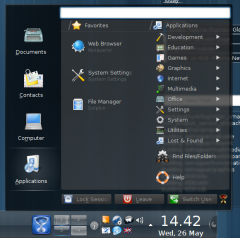 |
默认的 Lancelot |
点击添加到面板上的启动器图标,Lancelot 菜单便会弹出。
一共分四个区域 - 、、和。
区域
应用程序
「应用程序」区的左栏列出收藏的程序,右栏列出程序分类。如果要打开的程序不在「收藏」中,你可以点进程序分类。
点进「程序分类」后,「收藏」区域会消失让出空间便于浏览「程序分类」。用菜单顶部的「面包屑导航栏」可返回「收藏」。
计算机
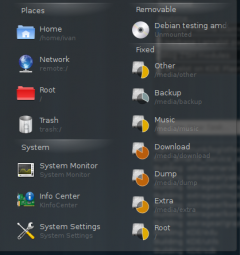 |
Lancelot 的计算机区 |
「计算机」区列出的有设定好的位置(Dolphin中的那个面板),一些有用的系统程序和存储驱动器。
右击驱动器-选择,你便可直接弹出/挂载/卸载移动设备。
联系人
「联系人」区列出 Akonadi(KMail)中的未读邮件和 Kopete 的在线联系人。
文档
The Documents section shows a list of office applications on the left, and a list of currently and recently opened documents on the right.
Searching capabilities
Lancelot provides all searching features KRunner has. You can use it to find applications, to do calculations, execute BASH commands, as a unit converter etc. For more details, see KRunner Usage.
If you don't like to use the mouse, every part of Lancelot can be accessed via keyboard.
| Action | Key | Description |
|---|---|---|
| Switch sections one by one | Page Up and Page Down | Shows previous and next section respectively |
| Switch to the specific section | Alt + number | Alt + 1 for Applications, Alt + 2 for Computer... |
| Activating items | Alt + letter | If an item has a letter underlined in its title, it can be activated by pressing together Alt and that letter |
| Moving through list items | Up and Down keys | |
| Moving between columns | Left and Right keys | |
| Activating the selected item | Enter | If no item is selected, the first search result is executed |
| Opening context menu for the selected item | Alt + Enter | |
| Search box completion | Tab and End; Left and Right keys | Tab and End keys use the whole suggestion while Left and Right move through the suggestion. |
More advanced topics
Advanced UI concepts
No-click activation
In order to reduce repetitive strain injuries produced by clicking the mouse buttons, Lancelot can be operated, if desired, without a single click.
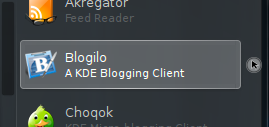
When you hover an item in the menu, a small icon that looks like a target with a mouse cursor drawn in it will appear. Instead of clicking, you can just hover the icon (or the area near it) and the item will be automatically activated.
Adaptive layout
The layout of the menu differs depending on the position of the applet which invoked it.
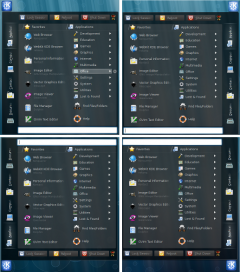
Always, the closest to the invoking applet (and the mouse cursor) are the section and system buttons, and the search box is on the opposite side since it has the focus by default and you don't need to click it in order to use it.
The sections are also reordered so that the Applications section is the closest to the mouse cursor.
Adaptive item sizes
The less items a list has, the larger the items and bigger the area for clicking.
When there are more items, Lancelot tries to show them all at once by reducing the size. If there are too many items to be shown all at once, the scrollbars are used as a solution.
Show sections inside the applet
If you think that the section buttons are too big and would be better if placed inside the panel itself, just right-click the applet, choose and .
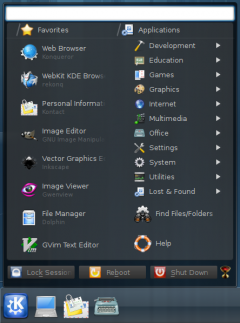
Show smaller section buttons
If you think that the section buttons are too big, but you don't want to place them inside the panel, just right-click them and choose .
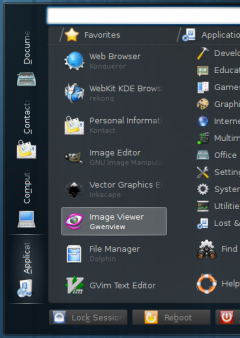
Custom system actions
If you don't use session switching (the 'switch user' feature), you can set different actions to the buttons in the bottom part of the window via the tab of the Lancelot's configuration dialogue.
Custom applications
You can choose which applications to show in the Documents and System sections via the tab of the Lancelot configuration dialogue.
Reordering items
You can change the order of favourite applications just by drag and drop. Mind that for it to work, you need to unlock your desktop first.
Some users prefer that the applications subcategories open in separate popups like they are used to from the classic menu from KDE 3. Since KDE SC 4.5, a new experimental feature was added to Lancelot which enables this behaviour.
To enable it, check the option in the tab of Lancelot's configuration dialogue.
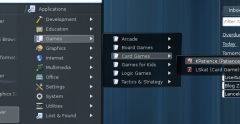
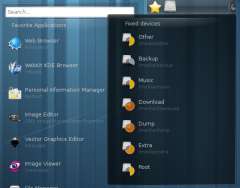
It is useful to have things that you use often placed on the desktop or the panel. For more info, see using the Shelf applet
